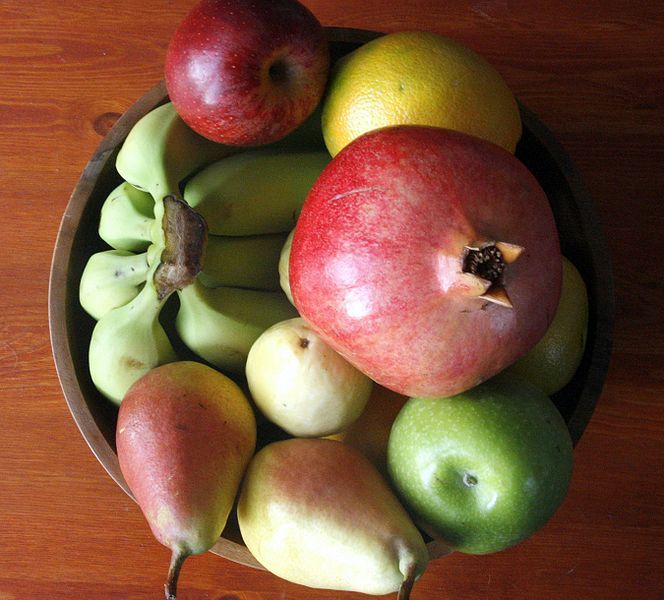Grocer's Last Problem
 At the end of the day, a grocer has 5 mangos, 4 apples, 3 bananas, 1 pear, 1 lemon and 1 pomegranate left. How many ways can a customer buy at least one fruit?
At the end of the day, a grocer has 5 mangos, 4 apples, 3 bananas, 1 pear, 1 lemon and 1 pomegranate left. How many ways can a customer buy at least one fruit?
Fruits of the same type are indistinguishable from each other.
Assume that everything that is mentioned is a fruit.
Image credit: Wikipedia - Yosarian
The answer is 959.
This section requires Javascript.
You are seeing this because something didn't load right. We suggest you, (a) try
refreshing the page, (b) enabling javascript if it is disabled on your browser and,
finally, (c)
loading the
non-javascript version of this page
. We're sorry about the hassle.
3 solutions
Where do you get the + 1 's from?
Log in to reply
There are five mangoes. A customer can choose either 0 , 1 , 2 , 3 , 4 , 5 mangoes. The + 1 is to account the case of without mangoes (or with all mangoes, or whatever number you didn't count yet). Do the same for the rest.
Log in to reply
So, the fundamental counting principle?
Log in to reply
@Pranav Harathi – I'm not sure what you mean by "fundamental counting principle", but yeah, it's pretty basic logic: there are n + 1 numbers among 0 , 1 , 2 , … , n .
if there are 15 fruits, the customer can buy them as 15c1+15c2+....+15c15 ways... so overall there should be (2^15)-1 ways to buy at least one fruit i.e. 32767. it isnt mentioned that in how many ways can he buy at least one different fruit..... please correct the question.....
Log in to reply
In your solution, you are ignoring the fact that fruits of the same kind are indistinguishable from each other. There are just 6 ways of choosing mangoes, because they are indistinguishable. But your solution will count it as 32 ways.
The number of ways of selecting a number of fruits from one type = n+1 where n is the number of fruits of that type because one may choose 0,1,2,...,n of that fruit.
Therefore number of ways to pick the fruits is ( 5 + 1 ) ( 4 + 1 ) ( 3 + 1 ) ( 1 + 1 ) ( 1 + 1 ) ( 1 + 1 ) − 1 = 9 5 9 Note that we subtract 1 because of the case where 0 fruits from each type are selected.
All fruits are indistinguishable. The only distinguishable stuff is their count. That means, a customer can pick up 0,1,2,3,4 or 5 mangoes. That means, mango can be picked up by a customer in 6 (0 to 5) ways. If the total count of a fruit is n, it can be picked in (n+1) ways. There are 6 different groups of fruits. Considering all of them, there could be (5+1)(4+1)(3+1)(1+1)(1+1)(1+1) = 960 ways a fruit could be picked up. But there is a final point to consider. It is said, the customer needs to choose 'at least' one fruit. So we need to exclude the case when all 6 categories are chosen 0 time i.e. no fruit is chosen at all. So, the answer will be, (960-1)=959
The number of ways of selecting at least 1 frm them is = (5+1)(4+1)(3+1)(1+1)(1+1)(1+1) - 1.... we are subtracting 1 from (5+1)(4+1)(3+1)(1+1)(1+1)(1+1) this value because this also includes the case of selecting no fruits from the given number of fruits.... so the answer is 960 - 1 = 959....